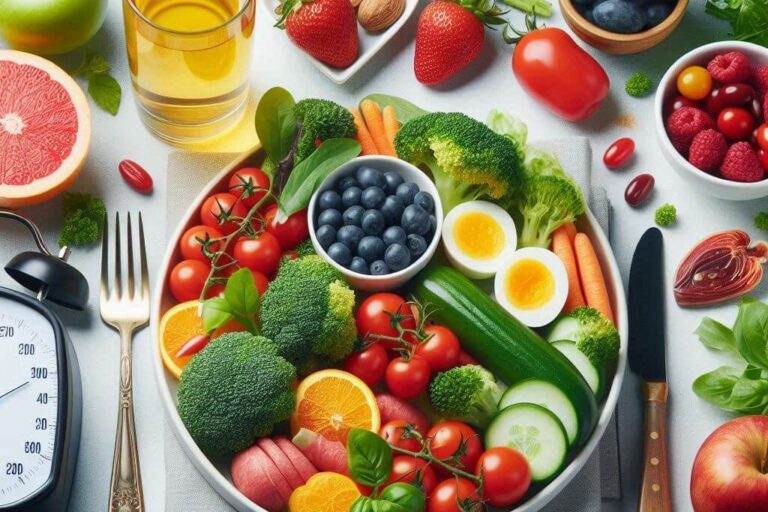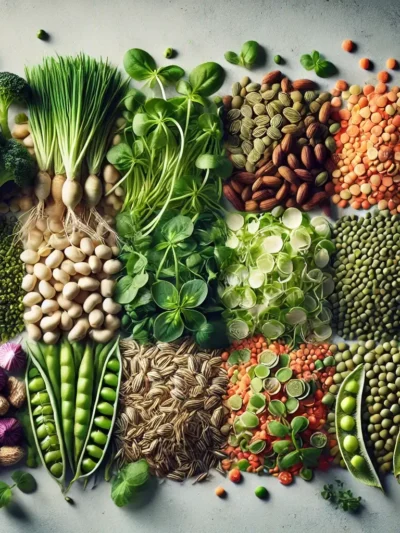Managing high blood pressure requires a holistic approach that combines a nutritious diet with healthy lifestyle habits.
This 3-day menu offers a practical guide to help you on this journey, prioritizing foods rich in essential nutrients and providing tips for effective blood pressure control. Dietary Approach to Stop Hypertension (DASH):
Day 1: Emphasizing Essential Nutrients for a Balanced Start
Breakfast (7:00 am):
- Whole Oats with Banana and Nuts: Start your day with a nutritious and tasty breakfast. Whole oats, rich in soluble fiber, promote satiety and help regulate cholesterol. Bananas, a source of potassium, help control blood pressure. Walnuts, rich in magnesium and fats good, complete the trio with their benefits for cardiovascular health.
Green Tea Sugar Free: A natural ally to help reduce inflammation and improve the health of blood vessels.
Morning Snack (10:00 am):
- Sliced Apple with Almond Butter: A delicious and nutritious combination. Apples, rich in pectin, promote satiety and help regulate blood sugar. Almond butter, rich in proteins, fibers and good fats, guarantees energy and lasting satiety.
Lunch (12:30 pm):
- Grilled Chicken Breast: A lean and versatile protein, rich in vitamins and minerals essential for muscle health. Grill the chicken without adding oil for a healthier option.
- Cooked Quinoa: A grain rich in protein, fiber, iron and magnesium, which masterfully replaces white rice, offering more nutrients and helping to regulate blood sugar levels.
- Steamed Broccoli: A green vegetable rich in vitamins, minerals, and antioxidant compounds that protect cells and fight inflammation. Steaming preserves its valuable nutrients.
- Green Salad with Olive Oil: An explosion of colors and flavors, green leaves provide vitamins, minerals and fiber, while olive oil, rich in monounsaturated fats, helps reduce LDL (“bad”) cholesterol.
- See more recipes to help you with the process
Afternoon Snack (3:30 pm):
- Plain Greek Yogurt with Fresh Strawberries: A light and refreshing option, plain Greek yogurt is rich in protein and probiotics, which benefit gut health and immunity. Fresh strawberries, rich in vitamin C and antioxidants, complement the flavor and provide essential nutrients.
Dinner (7:00 pm):
- Baked Salmon with Lemon: A rich source of omega-3 fatty acids, essential for cardiovascular and brain health. Lemon, rich in vitamin C, helps with iron absorption and improves immunity. Bake salmon without adding oil for a healthier option.
- Grilled Asparagus: A vegetable rich in vitamins, minerals, and antioxidant compounds that fight inflammation and protect cells, grilling asparagus preserves its valuable nutrients.
- Sweet Potato Mashed Potatoes: A more nutritious and tasty alternative to traditional mashed potatoes. Sweet potatoes are rich in vitamins, minerals and fiber, and have a lower glycemic index, which helps control blood sugar.
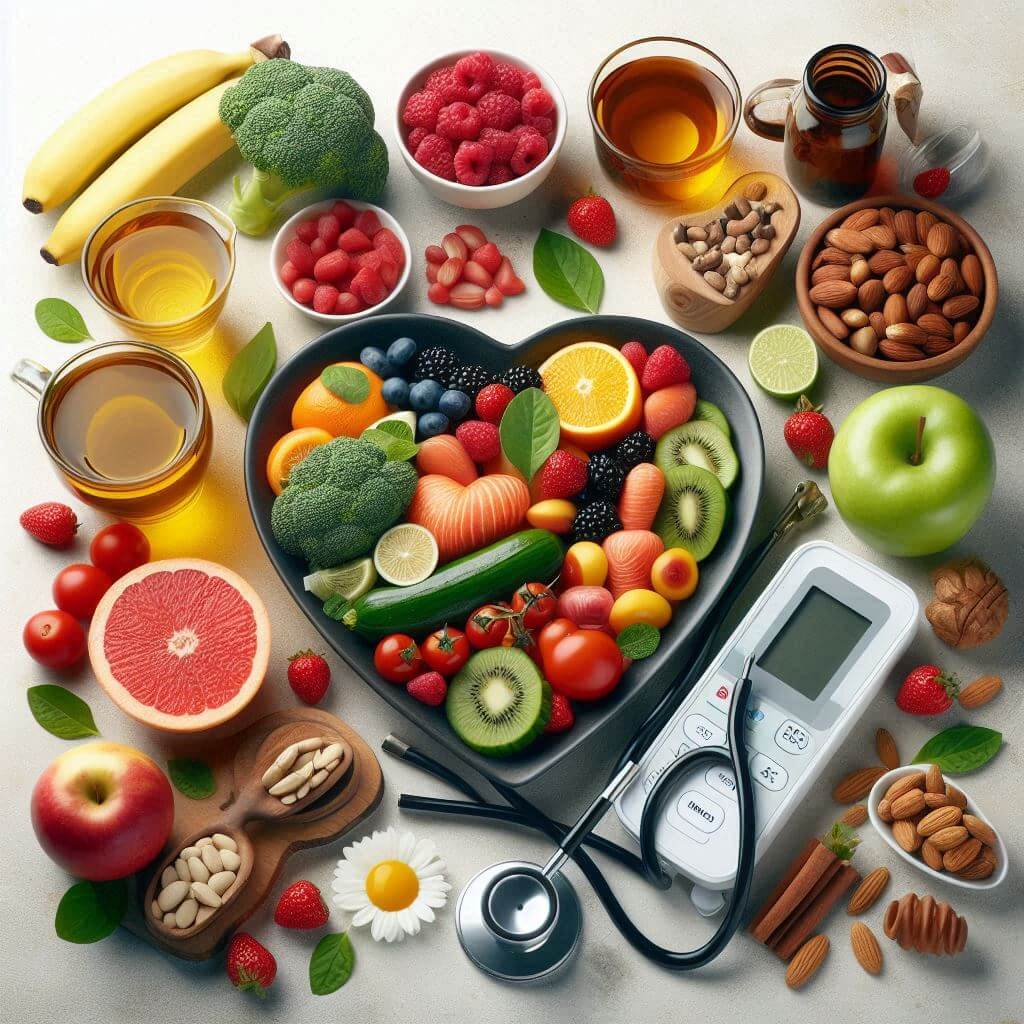
Notes:
- This menu provides about 1,800 calories and 2,000 mg of potassium per day.
- Portions can be adjusted according to your individual needs.
- Consult a nutritionist for an individualized assessment and a personalized eating plan.
Day 2: Tackling High Blood Pressure with Antioxidants
Breakfast (7:00 am):
- Spinach with Egg Omelette and Tomato: A light and nutritious option, rich in proteins, vitamins and minerals. Spinach, rich in iron and vitamins A and C, helps with blood and vision health. Tomatoes, rich in lycopene, a powerful antioxidant, protect cells against free radical damage.
- A Slice of Pineapple: A tropical fruit rich in vitamin C, which strengthens the immune system and aids in the absorption of iron. It also contains bromelain, an enzyme that can aid digestion.
Morning Snack (10:00 am):
- A Handful of Nuts: A concentrated source of good fats, protein, fiber and magnesium, walnuts help reduce LDL (“bad”) cholesterol and control blood pressure.
Lunch (12:30 pm):
- Cucumber, Tomato, Olive, Tuna and Chickpea Salad: A refreshing and nutritious option, rich in protein, fiber, vitamins and minerals. Tuna, an excellent source of omega-3, contributes to cardiovascular health. Chickpeas, rich in fiber and protein, promote satiety and help control blood sugar. see more salads
- Cooked Quinoa: It is repeated as a side dish, due to its numerous nutritional benefits.
Afternoon Snack (3:30 pm):
- Antioxidant Smoothie with Blueberries, Strawberries, Greek Yogurt and Honey: A refreshing and nutritious option, rich in antioxidants, vitamins, minerals and probiotics. Blueberries and strawberries are excellent sources of antioxidants, which protect cells from free radical damage. Greek yogurt, rich in protein and probiotics, benefits intestinal health. More smoothies
Dinner (7:00 pm):
- Chicken Curry with Vegetables (Broccoli, Cauliflower, Carrots): A tasty and nutritious option, rich in protein, fiber, vitamins and minerals. Curry, in addition to adding flavor, has anti-inflammatory properties. Vegetables provide a variety of essential nutrients.
- Brown Rice: A more nutritious alternative to white rice, rich in fiber and B vitamins.
- See more recipes to help you with the process
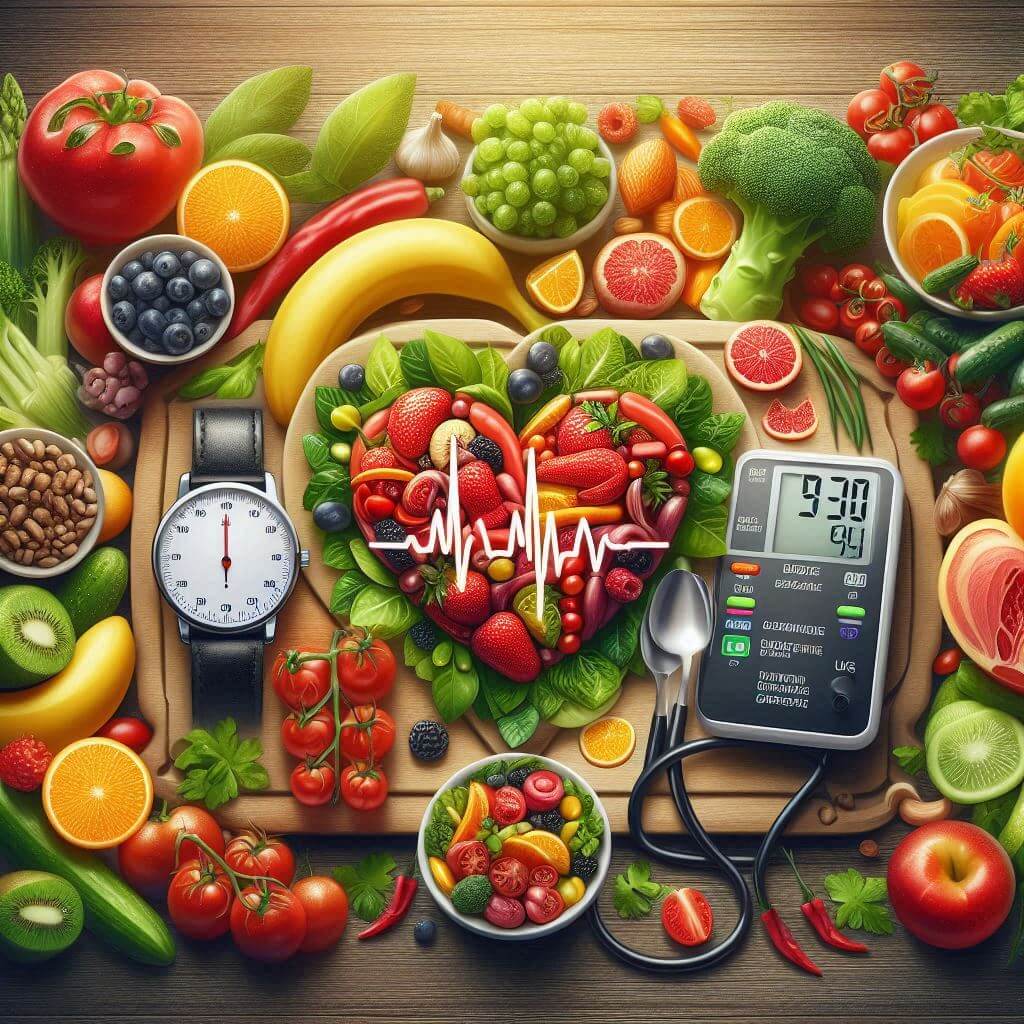
Notes:
- This menu continues to emphasize foods rich in nutrients, antioxidants, and minerals essential for controlling blood pressure.
- The inclusion of fish such as salmon and tuna is important for the supply of omega-3 fatty acids.
- The variety of colorful fruits and vegetables ensures a wide range of nutrients.
Day 3: Focus on Reducing Sodium and Boosting Potassium
Breakfast (7:00 am):
- Green Smoothie with Spinach, Banana, Avocado and Coconut Water: A refreshing and nutritious option, rich in potassium, fiber, good fats and vitamins. Spinach and avocado are excellent sources of potassium, which helps balance sodium levels. Coconut water is a natural source of electrolytes. More smoothies
Morning Snack (10:00 am):
- A Handful of Almonds: A concentrated source of protein, fiber, good fats and magnesium, almonds help reduce LDL (“bad”) cholesterol and control blood pressure.
Lunch (12:30 pm):
- Grilled Chicken Breast: It is repeated as a source of lean protein.
- Cooked Quinoa: Repeat as accompaniment.
- Cucumber and Tomato Salad with Olive Oil: A light and refreshing option, rich in potassium and vitamins. Cucumber, with its high water content, contributes to hydration. see more salads
Afternoon Snack (3:30 pm):
- A Handful of Grapes: A fruit rich in antioxidants, potassium and vitamin C. Grapes also have anti-inflammatory properties.
Dinner (7:00 pm):
- Grilled Tilapia with Lemon: A light and tasty option, rich in protein and omega-3. Tilapia is an alternative to salmon, also rich in heart-healthy fatty acids.
- Steamed Asparagus: It is repeated as a source of vitamins, minerals and antioxidants.
- Baked Potato: A healthier alternative to French fries, rich in potassium and fiber.
- See more recipes to help you with the process
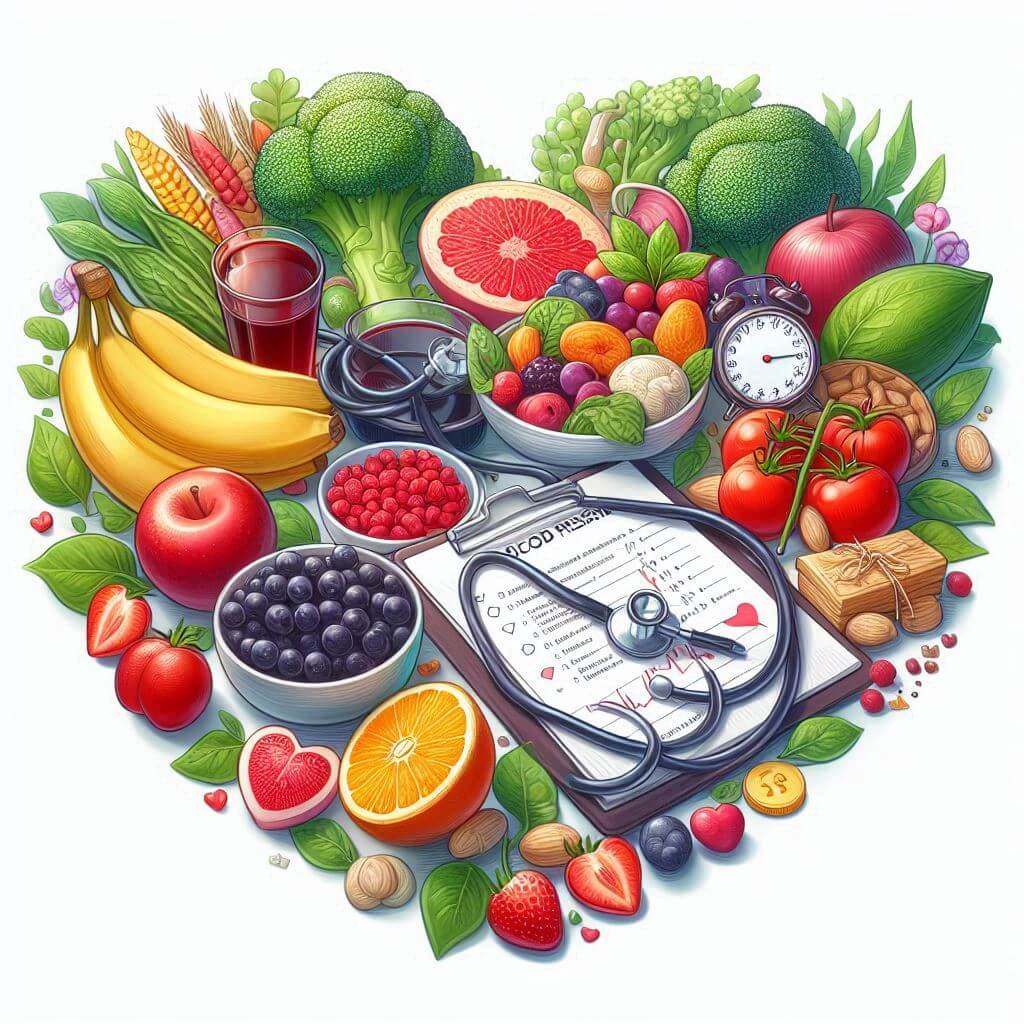
Notes:
- This menu emphasizes foods that are high in potassium and low in sodium.
- Proper hydration is essential for controlling blood pressure, so drink water regularly throughout the day.
- Avoid processed foods and foods high in sodium, such as sausages, snacks and fast food.
Important Reminders:
- This menu is a general guide and can be adapted to suit your individual preferences and needs.
- Consult a nutritionist or doctor for personalized guidance.
- Combining a healthy diet with regular physical activity is essential for controlling blood pressure.
- Gradually reduce your caffeine and alcohol intake.
- Keep your weight under control, as being overweight can contribute to high blood pressure.
By following these guidelines and incorporating healthy lifestyle habits, you will be taking an important step towards controlling your blood pressure and improving your quality of life.
Exercise Routines for Blood Pressure Control: Complementing the Menu for Complete Cardiovascular Health
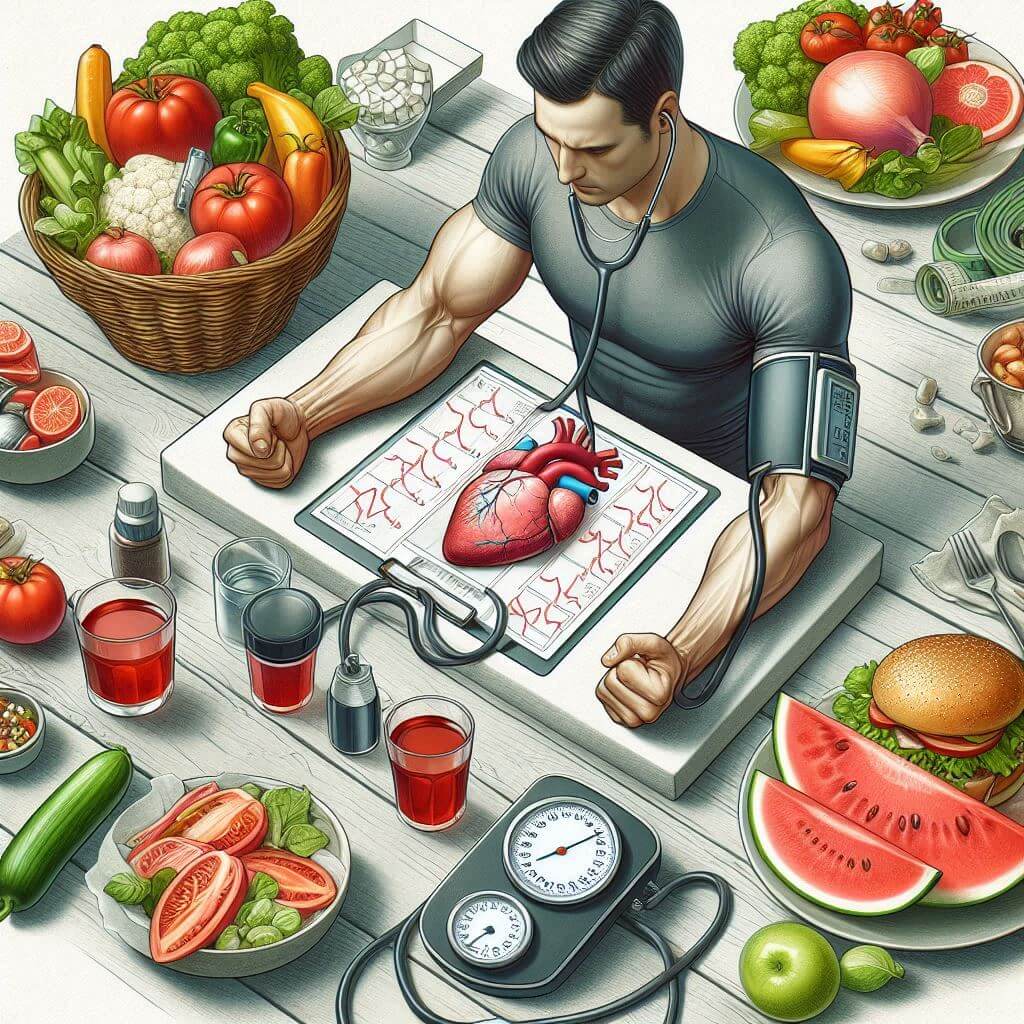
Regular physical activity is crucial for controlling hypertension, complementing the benefits of a nutritious diet.
By exercising, you improve blood circulation, strengthen your heart and lungs, reduce stress, and promote overall well-being.
Recommended Exercise Types:
- Aerobics: Walking, running, swimming, cycling, dancing and others exercises that elevate the heart rate for sustained periods (at least 30 minutes on most days of the week).
- Strength Training: Weight training, bodyweight exercises or resistance bands, performed 2 to 3 times a week, to strengthen muscles and improve endurance.
- Flexibility and Stretching Exercises: Yoga, Pilates or simple stretches performed daily to increase flexibility and range of motion.
General Recommendations:
- Consult a physician or fitness professional before beginning any exercise program, especially if you have high blood pressure or other health conditions.
- Start slowly and gradually increase the intensity and duration of your exercises over time.
- Choose activities that you enjoy and feel motivated to do.
- Listen to your body and rest when necessary.
- Stay hydrated during and after exercise.
- Monitor your blood pressure regularly.
Benefits of Exercise for Blood Pressure:
- Reduces systolic and diastolic blood pressure.
- Improves blood circulation.
- Strengthens the heart and lungs.
- Helps in weight loss.
- Reduces stress.
- Improves mood and sleep quality.
- Reduces the risk of heart disease, stroke and diabetes.

Remember: Regular physical activity is an essential component of controlling hypertension and promoting overall cardiovascular health. Combine a nutritious diet with physical exercises regular to achieve complete well-being and enjoy a healthier, more active life. Effect of Regular Physical Activity on Blood Pressure:
Additional Tips:
- Monitor your progress and set realistic goals.
- Find an exercise partner or join an exercise group to motivate yourself.
- Make exercise part of your daily routine.
- Reward yourself for your successes.
By committing to a lifestyle By eating a healthy diet that includes a balanced diet and regular exercise, you will be investing in your future and your long-term cardiovascular health.
See the most frequently asked questions.
| Question | Response |
|---|---|
| What is high blood pressure? | Hypertension, also known as high blood pressure, is a common chronic condition that affects millions of people worldwide. It is characterized by the high force of blood pushing against the walls of the arteries, which can lead to a number of serious health problems, such as heart disease, stroke, kidney failure and aneurysms. |
| What are the symptoms of hypertension? | In most cases, hypertension has no symptoms, which is why it is known as the “silent killer”. However, some signs may indicate the presence of the disease, such as: Frequent headaches Dizziness or vertigo Fatigue Difficulty breathing Ringing in the ears Nosebleeds |
| What are the causes of hypertension? | Hypertension is a multifactorial condition, meaning that several factors can contribute to its development, including: Family history: People with close relatives with high blood pressure have a higher risk of developing the disease. Eating habits: A diet high in sodium, saturated fat, and cholesterol and low in potassium and fiber can increase the risk of high blood pressure. Overweight or obesity: Excess body weight increases pressure on the arteries and heart, increasing the risk of high blood pressure. Sedentary lifestyle: Lack of regular physical activity contributes to increased blood pressure. Excessive alcohol consumption: Excessive alcohol consumption can raise blood pressure. Smoke: Smoking damages your arteries and increases your risk of high blood pressure, heart disease and stroke. Stress: Chronic stress can trigger high blood pressure. Chronic diseases: Diabetes, kidney disease, and sleep apnea can increase your risk of high blood pressure. |
| How can I control my blood pressure? | Controlling blood pressure involves adopting a healthy lifestyle that combines a balanced diet with regular exercise. In some cases, medication may also be necessary. |
| What dietary changes can I make to control my blood pressure? | Key dietary changes to control blood pressure include: Sodium reduction: Avoid processed foods, cold cuts, snacks, ready-made sauces and industrial seasonings, which are generally high in sodium. Opt for natural seasonings such as herbs and spices to season your meals. Increased potassium intake: Potassium helps balance the effects of sodium in the body. Foods rich in potassium include bananas, potatoes, spinach, avocados, lentils, and beans. Consumption of more fiber: Fiber helps reduce LDL (“bad”) cholesterol and control blood sugar levels, as well as promoting satiety. Sources of fiber include fruits, vegetables, whole grains, and legumes. Choice of healthy fats: Choose unsaturated fats found in olive oil, avocado, nuts and oily fish, such as salmon and sardines. Limit your intake of saturated and trans fats, found in red meat, fried foods and processed foods. Drink plenty of water: Proper hydration is essential for cardiovascular health and helps control blood pressure. Drink at least 2 liters of water per day. |
| What kind of exercises should I do to control my blood pressure? | Regular physical activity is crucial for controlling blood pressure. Recommended exercises include: Aerobics: Walking, running, swimming, cycling, dancing, and other exercises that elevate your heart rate for sustained periods (at least 30 minutes most days of the week). Strength Training: Weight training, bodyweight exercises or resistance bands, performed 2 to 3 times a week, to strengthen muscles and improve endurance. Flexibility and Stretching Exercises: Yoga, Pilates or simple stretches performed daily to increase flexibility |

